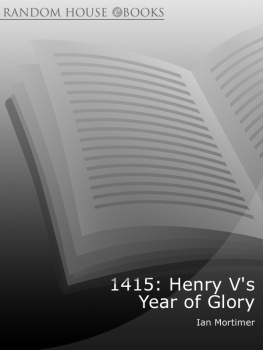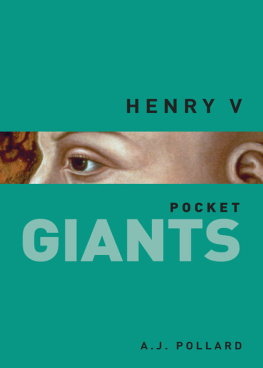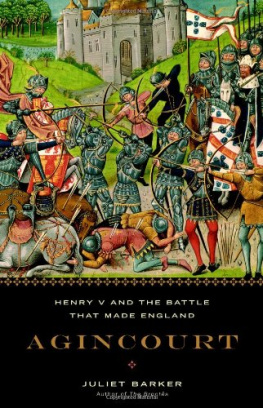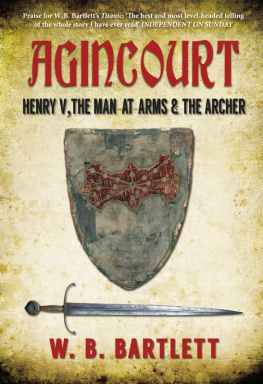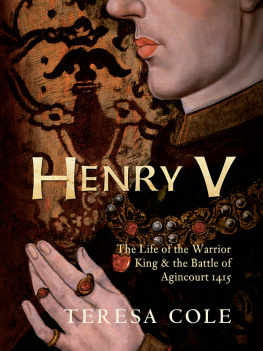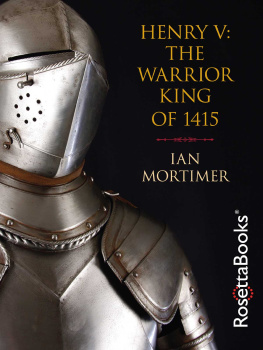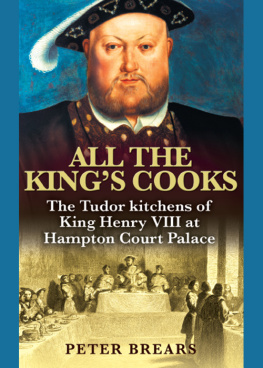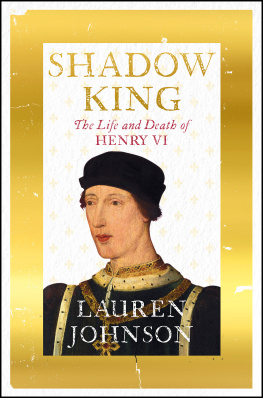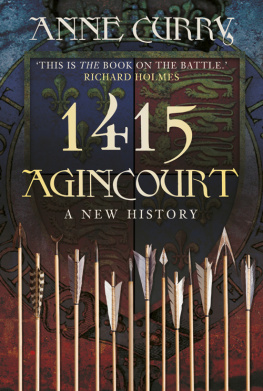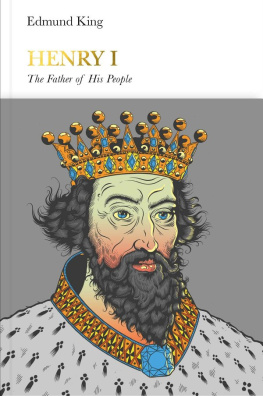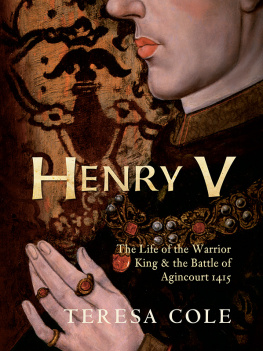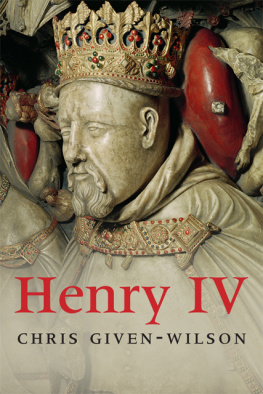About the Book
Henry V is regarded as the great English hero. Lionised in his own lifetime for his victory at Agincourt, his piety and his rigorous application of justice, he was elevated by Shakespeare into a champion of English nationalism. But does he really deserve to be thought of as the greatest man who ever ruled England?
In Ian Mortimers groundbreaking book, he portrays Henry in the pivotal year of his reign; recording the dramatic event of 1415, he offers the fullest, most precise and least romanticised view we have of Henry and of what he did. The result is not only a fascinating reappraisal of Henry; it brings to the fore many unpalatable truths which biographies and military historians have largely ignored. At the centre of the book is the campaign which culminated in the battle of Agincourt: a slaughter ground designed not to advance Englands interest directly but to demonstrate Gods approval of Henrys royal authority on both sides of the channel.
IAN MORTIMER
1415
Henry Vs Year of Glory
This ebook is copyright material and must not be copied, reproduced, transferred, distributed, leased, licensed or publicly performed or used in any way except as specifically permitted in writing by the publishers, as allowed under the terms and conditions under which it was purchased or as strictly permitted by applicable copyright law. Any unauthorised distribution or use of this text may be a direct infringement of the authors and publishers rights and those responsible may be liable in law accordingly.
Version 1.0
Epub ISBN 9781448103775
www.randomhouse.co.uk
Published by Vintage 2010
2 4 6 8 10 9 7 5 3 1
Copyright Ian Mortimer 2009
Ian Mortimer has asserted his right under the Copyright, Designs and Patents Act 1988 to be identified as the author of this work
This book is sold subject to the condition that it shall not, by way of trade or otherwise, be lent, resold, hired out, or otherwise circulated without the publishers prior consent in any form of binding or cover other than that in which it is published and without a similar condition, including this condition, being imposed on the subsequent purchaser
First published in Great Britain in 2009 by The Bodley Head
Vintage
Random House, 20 Vauxhall Bridge Road,
London SW1V 2SA
www.vintage-books.co.uk
Addresses for companies within The Random House Group Limited can be found at: www.randomhouse.co.uk/offices.htm
The Random House Group Limited Reg. No. 954009
A CIP catalogue record for this book is available from the British Library
ISBN 9781845950972
Contents
This book is dedicated to my brother
Robert Mortimer,
a fire-fighter, a saver of lives
a real hero
and the kindest of men.
About the Author
Ian Mortimer has BA and PhD degrees in history from Exeter University and an MA in archive studies from University College London. He was elected a Fellow of the Royal Historical Society in 1998, and was awarded the Alexander Prize (2004) by the Royal Historical Society for his work on the social history of medicine. He is the author of three other medieval biographies, The Greatest Traitor: The Life of Sir Roger Mortimer (2003), The Perfect King: The Life of Edward III (2006) and The Fears of Henry IV: The Life of Englands Self-Made King (2007) as well as the bestselling The Time Travellers Guide to Medieval England (2008). He lives with his wife and three children on the edge of Dartmoor.
ALSO BY IAN MORTIMER
The Greatest Traitor:
The Life of Sir Roger Mortimer,
1st Earl of March,
Ruler of England, 13271330
The Perfect King:
The Life of Edward III,
Father of the English Nation
The Fears of Henry IV:
The Life of Englands Self-made King
The Time Travellers Guide to
Medieval England:
A Handbook for Visitors to the
Fourteenth Century
Authors Note
Foreign names have been treated in two ways. Members of the French royal family, including royal cousins (e.g. John the Fearless; Philip, count of Vertus) have been given in English. French individuals who were not members of the royal family have been named in French (e.g. Jean Petit, Jehanne de Lesparre) with the exception of the one reference to Joan of Arc, whose name is well known in the English-speaking world. Other foreign names have normally been given in the usual spelling in the original language e.g. Duarte of Portugal, Joo of Portugal, Juan of Castile, Pedro de Luna, Giovanni Dominici where possible. However, some Eastern European names have been given in English, e.g. Lord John of Chlum, Wenceslas of Dub and Peter of Mladoovice.
With regard to currencies, readers might like to bear in mind that the pound sterling () was just one of two units of account in England. The other was the mark, which was the equivalent of two-thirds of a pound, or 13 shillings and 4 pence (13s 4d). Thus the gold coin called a noble 6s 8d was one third of 1 and one half of a mark,
French money has usually been quantified in terms of crowns (cus la couronne). The usual conversion rate has been taken as 6 crowns to 1 (so one French gold crown = one English gold half-noble). The discussion concerning the dowry of the Princess Katherine in early June 1415 touched upon treating the matter in terms of francs; as explained in the text, the franc was worth very slightly less, there being about 10.5 francs to 10 crowns.
The term Gascony in this book should be taken to mean all the territory under English rule in the southwest of France, as in my previous books.
List of Illustrations
. Portrait of Henry V, c. 1523, probably copied from a lost original (The Royal Collection 2009 Her Majesty Queen Elizabeth II, RCIN 403443).
. Effigy of Henry IV in Canterbury Cathedral (authors collection).
. Effigy of Queen Joan in Canterbury Cathedral (authors collection).
. Effigy of Thomas, duke of Clarence, in Canterbury Cathedral (Dean and Chapter of Canterbury Cathedral).
. Manuscript illumination of John, duke of Bedford, from the Bedford Hours (British Library, Add MS 18850 fol. 256v.).
. Sixteenth-century crayon drawing by J. le Boucq of Humphrey, duke of Gloucester, copied from a lost portrait (Mdiathque dArras, bibliothque municipale dArras, MS Arras 266).
. Effigy of Henry Beaufort, bishop of Winchester, in Winchester Cathedral (authors collection).
. Effigy of Henry Chichele, archbishop of Canterbury, in Canterbury Cathedral (Ric Horner).
. Effigy of Ralph Neville, earl of Westmorland, and his wives in Staindrop Church, County Durham (Dr John Banham).
. Effigy of Thomas Fitzalan, earl of Arundel, and his wife, Beatrice, in Arundel Castle Chapel, English School, fourteenth century (His Grace The Duke of Norfolk, Arundel Castle/Bridgeman Art Library).
. Effigy of Richard Beauchamp, earl of Warwick, in St Marys Church, Warwick (authors collection).
. Manuscript illumination of London, from A volume of Poems of Charles dOrlans and other works (British Library, Royal MS 16 F ii fol. 73 r.).
. Westminster Hall (Robert Harding Picture Library Ltd/Alamy).
. Engraving of Westminster Palace, after a drawing by Wenceslas Hollar (

